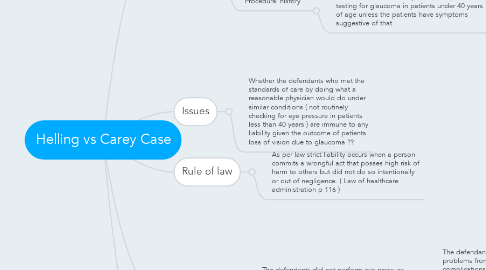
1. Facts
1.1. Parties
1.1.1. Plaintiff ( Ms Barbara Helling )
1.1.2. Defendants ( Dr Carey and Dr Laughlins ) opthamologists
1.2. What happened
1.2.1. Plaintiff was first seen by the defendants in 1959 for myopia when she was prescribed contact lenses
1.2.1.1. She was subsequently seen multiple times by the defendants for visual problems from sept 1963 until Oct 1968
1.2.1.1.1. It was thought that the visual problems was due to problems with her contact lenses
1.2.2. In Oct 1968 Dr Carey checked plaintiff eye pressure and diagnosed her with glaucoma
1.2.2.1. At this time the plaintiff had already lost her peripheral vision and her central vision was greatly decreased
1.2.3. In August 1969 the plaintiff filed a case against the defendants for negligence
1.3. Procedural history
1.3.1. Trail court concluded that the standards of care for a reasonable physician under similar circumstance did not require routine pressure testing for glaucoma in patients under 40 years of age unless the patients have symptoms suggestive of that
1.3.1.1. Trail court made the judgement in favor of the defendants
1.3.1.1.1. Supreme court reversed the judgement made in the jury court and court of appeals and new trail started on issues of damage only
2. Issues
2.1. Whether the defendants who met the standards of care by doing what a reasonable physician would do under similar conditions ( not routinely checking for eye pressure in patients less than 40 years ) are immune to any liability given the outcome of patients loss of vision due to glaucoma ??
3. Rule of law
3.1. As per law strict liability occurs when a person commits a wrongful act that posses high risk of harm to others but did not do so intentionally or out of negligence. ( Law of healthcare administration p 116 )
4. Analysis
4.1. The defendants did not perform eye pressure testing despite multiple patient visits for vision problems from Sept 1963-Oct 1968
4.1.1. The defendants misdiagnosed the visual problems from being solely from complications from contact lenses when it was probably because of glaucoma, which if diagnosed early enough is easily treatable and blindness could have been prevented
4.1.1.1. The testing for glaucoma is inexpensive, easy to perform and results are readily available
4.1.1.1.1. Glaucoma is easily treatable if diagnosed early
